It is wrong to blame human activity and ‘climate change’ for strength of hurricane
Storms of similar size and strength hit Tampa Bay area in 1848 and 1921 when human contributions to carbon dioxide in atmosphere was negligible
Even the United Nations’ Intergovernmental Panel on Climate Change (IPCC) says there’s no climate signal in tropical storms
ARLINGTON HEIGHTS, IL (October 8, 2024) – Hurricane Milton is on track Wednesday to be one of the biggest storms to ever hit the Tampa Bay, Florida area, and is one of the few Category 5 hurricanes on record in the satellite era (1966-onwards). It may join Hurricane Michael in 2018 as the only Category 5 hurricanes to form in the Gulf of Mexico in October and make landfall at that strength.
While the history of Gulf hurricanes growing this strong and making a direct hit on Tampa Bay shows this is a rare occurrence, it is not unprecedented and “climate change” driven by human emissions of carbon dioxide is not to blame.
Climate and environment experts at The Heartland Institute – James Taylor, Anthony Watts, H. Sterling Burnett, Linnea Lueken, and Steven Milloy – are available to the media to provide historical context for this storm.
They provide quotes below the following facts and perspective section of this release. To reach them for comment, please contact Vice President and Director of Communications Jim Lakely at [email protected] or call/text 312-731-9364.
FACT: Milton not without precedent
Storms of similar size and strength struck the Tampa Bay area in 1848 and 1921. And the National Oceanic and Atmospheric Administration has tracked at least 146 hurricanes that have formed in the Gulf since 1851.
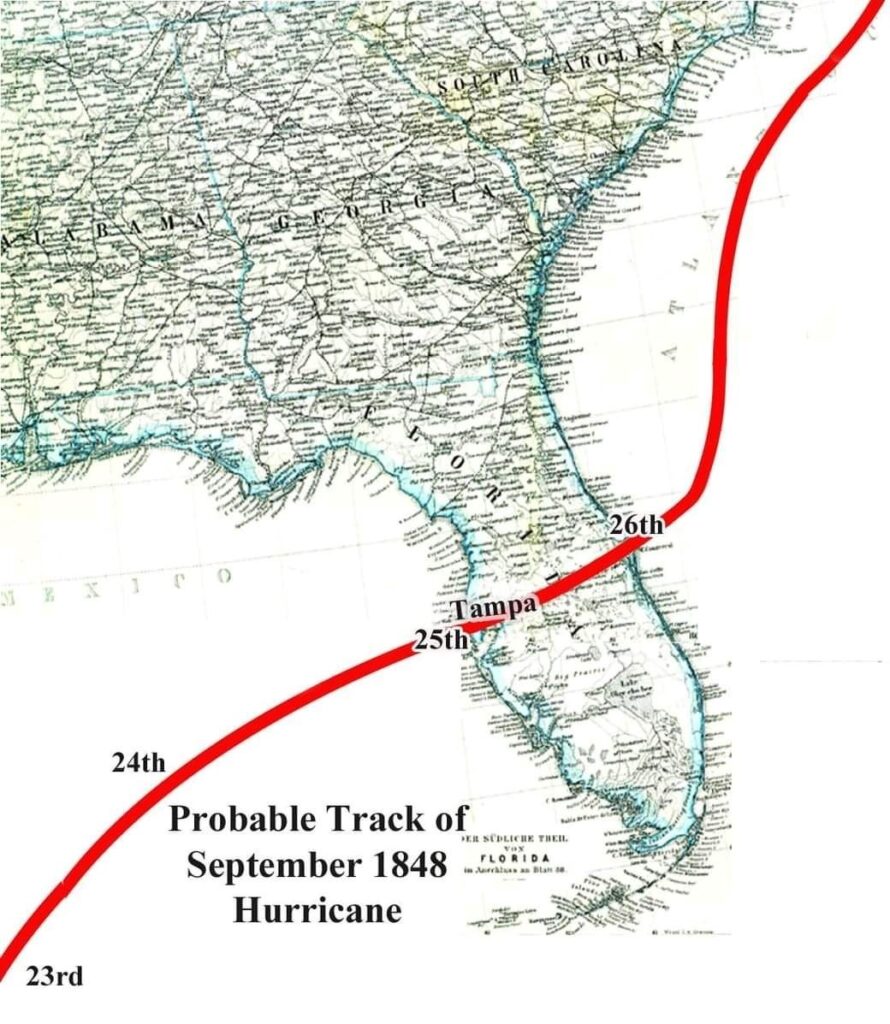
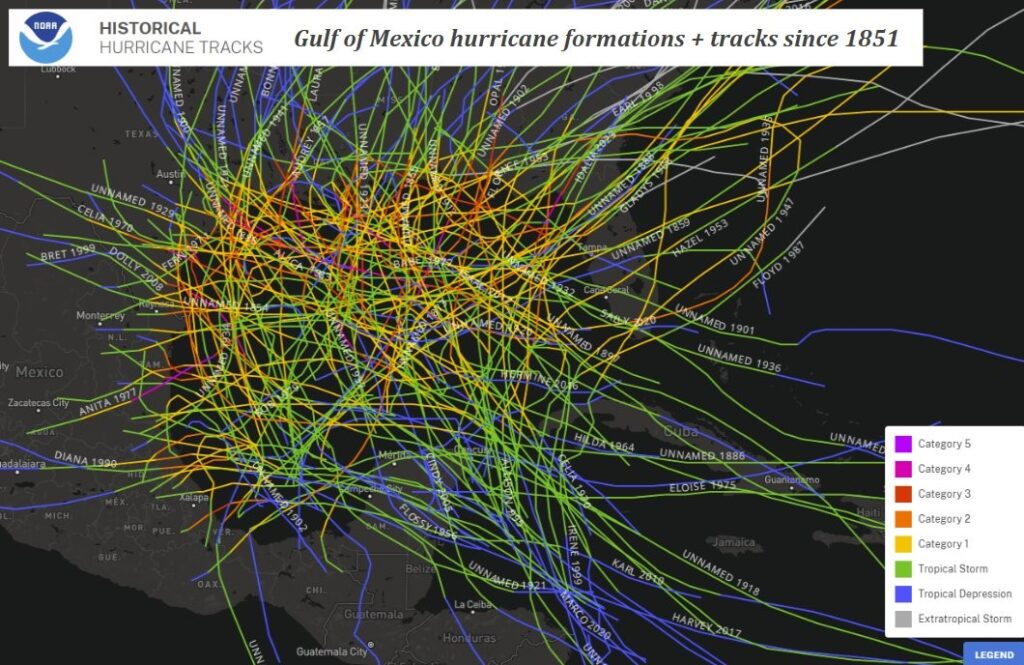
Historical data show there has been little to no long-term trend since 1900 in Florida major hurricane activity through Hurricane Helene, which hit the panhandle last month.
People born in the 1950s or later did not experience the record-high hurricane activity of the 1940s, and the early 1900s activity was likely under-reported as virtually no one lived in Florida in 1900.
The following plot shows the intensity of major hurricanes (100 knots or greater maximum sustained wind speed) striking Florida since 1900, updated through Helene:
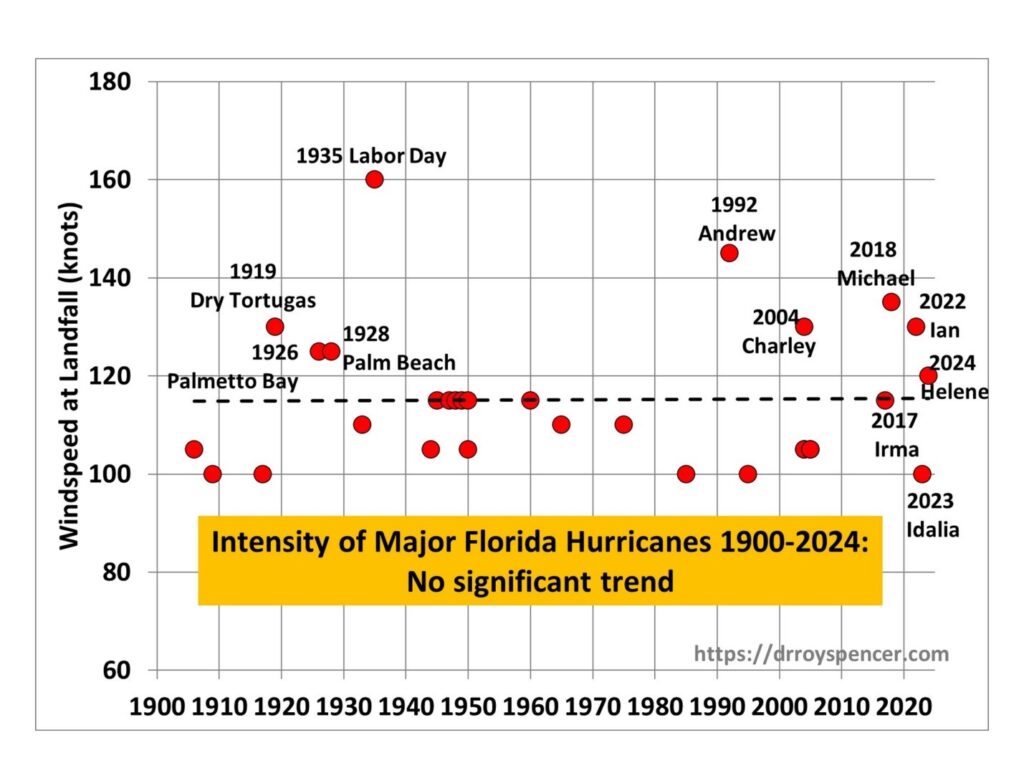
FACT: No trend in hurricane “intensification”
Many may claim that the rapid intensification of Milton is unprecedented. That is also false. As the chart below shows – based on a study in the journal Geophysical Research Letters – there is no significant upward trend in “rapid intensification” in hurricanes that form in the North Atlantic and Gulf of Mexico in the last 33 years.
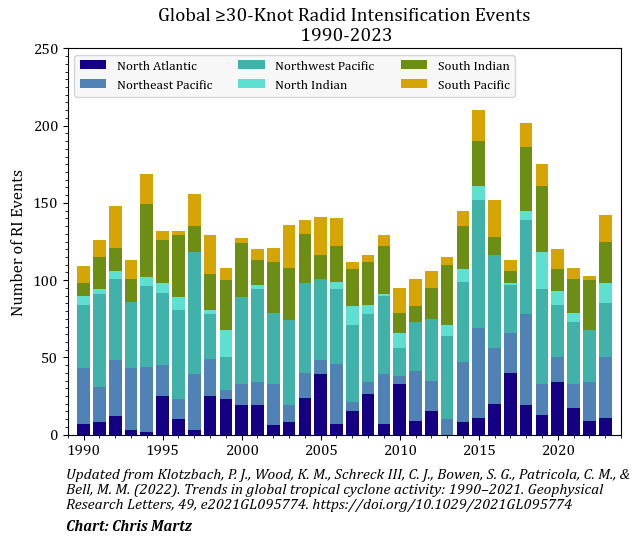
FACT: No upward trend in hurricane activity
There is also no upward trend in global cyclone activity since 1980.
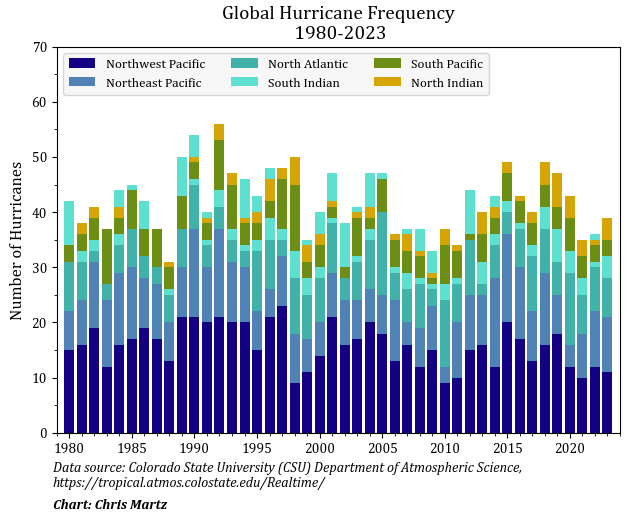
FACT: IPCC says no climate signal in tropical storms
Climate science itself says there is no connection between climate change and hurricane strength or frequency. In Table 12.12 on Page 90 – Chapter 12 of the UN Intergovernmental Panel on Climate Change (IPCC) Sixth Assessment Report (2023). Emergence of Climate Impact Drivers (CIDs) in time periods, shows no indication of a connection in the present, nor in the future.
The color in the table below corresponds to the confidence of the region with the highest confidence: white colors indicate where evidence of a climate change signal is lacking or the signal is not present, leading to overall low confidence of an emerging signal. Note the colors for Tropical Cyclones in the table screencap below:

The following statements may be used with attribution. For more information about historical trends, please visit The Heartland Institute’s Climate at a Glance website.
- Florida, and especially the Tampa area, has been enjoying a golden age of hurricane avoidance.
- The Tampa area is uniquely vulnerable to hurricane strikes and a major hurricane strike will likely be catastrophic, even apocalyptic. Scientists tell us it is remarkable that no major hurricanes have struck Tampa for more than a century, and Tampa has long been overdue for another major hurricane.
- The fact that such a remarkable streak without a major hurricane strike may finally come to an end is not an indictment of climate change, but an illustration of how hurricanes are becoming rarer as the planet modestly warms.
- Climate scammers will undoubtedly attempt to link Hurricane Milton to climate change. However, hurricane activity – affecting Florida and America as a whole – is less frequent and severe than was the case decades ago. Climate change may not make all hurricanes disappear, but hurricanes are becoming less frequent and severe as the planet modestly warms.
- Meteorologists report that upper atmosphere wind shear will likely disrupt Hurricane Milton and reduce its power and speed before its Florida landfall. Scientists have long connected warmer global temperatures with stronger upper atmosphere wind shear inhibiting hurricane formation and strength. This is why warmer water temperatures have not “supercharged” hurricanes.
- Florida recently underwent an 11-year period without a major hurricane strike (ending in 2017), which is by far the longest such period in recorded history.
- Florida recently underwent a 10-year period without a single hurricane strike of any size (ending in 2016), which is by far the longest such period in recorded history.
- From 2009 through 2017, the U.S. experienced fewer hurricane strikes than during any other time period in recorded history.
- The United States recently underwent a record 11 years without a major hurricane strike of Category 3 or higher (2005-2017).
James Taylor
President
The Heartland Institute
[email protected]
“We, of course, don’t know at this stage how powerful Milton will be when it makes landfall or where precisely it will strike, but if it hits Tampa Bay as is forecast, it will cause massive destruction. If it does, however, neither the hurricane itself in terms of strength or speed of formation, the timing in the hurricane season, nor the location will be unprecedented as so many stories have claimed. Neither data, nor the IPCC’s most recent assessment, provide any support for the claim that climate change is causing a worsening of hurricanes.
“Rather, the damage Milton wreaks in Tampa Bay, or wherever it ultimately makes landfall, will be the only unprecedented thing about it and that is not due to changed climate conditions but rather changed demographics. There is simply more people, property, and infrastructure in and around Tampa Bay than there was when similar hurricanes made a direct strike on the city in 1921 and 1848 – 103 and 176 years of global warming ago respectively.
“In 1921, Tampa Bay’s population was 135,000. Now it sits at more than three million. Hopefully, most people will heed the early warnings afforded by available technology and get out of harm’s way so fatalities, if any, will be low. But you can’t move homes and infrastructure, so the damage will be quite high – not due to the changing nature of hurricane, but to the expanding bulls-eye effect: more people and stuff in harm’s way means more damage.
“I pray wind shear knocks it down and/or it strikes a less inhabited area of the nation.”
H. Sterling Burnett, Ph.D.
Director, Arthur B. Robinson Center on Climate & Environmental Policy
The Heartland Institute
Managing Editor, Environment & Climate News
[email protected]
214/909-2368
“While many in the media have been painting Hurricane Milton as ‘unprecedented’ with it being ‘juiced’ by climate change, a review of the factual record and scientific literature say otherwise. Tampa Bay has experienced major hurricanes in 1848 and in 1921, well before climate change was ever conceived.
“Further, the Intergovernmental Panel on Climate Change (IPCC) in their most recent report showed clearly, they found no signature of climate change affecting hurricanes in any way. Milton’s 897mb lowest pressure isn’t even unprecedented, being the fifth lowest on record. While Milton remains dangerous, the attempt to paint it as a monster driven by climate change just doesn’t hold up under scrutiny and is unhelpful to those affected.”
Anthony Watts
Senior Fellow
The Heartland Institute
[email protected]
“Undoubtedly the focus of the media after Hurricane Milton will be on the climate change angle, despite the facts, and rapid-attribution con ‘studies’ will quickly come out to support the media narrative. It is a shame that instead of focusing on things that would actually help decrease the impact of natural hurricanes – such as storm resilient infrastructure and dispatchable power – the media will almost certainly promote fake news in order to generate even more fear and confusion.
“In the past, Florida’s government (especially recently) has been pretty good about responding to these disasters quickly and staying focused on helping people rather than wasting time playing the climate change card and shifting responsibility onto the people for daring to demand stable and affordable power. Let us hope this trend continues.”
Linnea Lueken
Research Fellow
Arthur B. Robinson Center on Climate and Environmental Policy
The Heartland Institute
[email protected]
“The Tampa Bay area has been hit by mega-hurricanes at least twice before (1848 and 1921), there is no trend in hurricanes hitting Florida, no aspect of hurricanes is outside the range of natural variability, and it’s impossible for emissions to affect hurricanes in the first place since emissions physically can’t warm the oceans. Blaming hurricanes on emissions is an absolutely bankrupt claim.”
Steven Milloy
Senior Policy Fellow, E&E Legal
Policy Advisor, The Heartland Institute
[email protected]
The Heartland Institute is a national nonprofit organization founded in 1984 and headquartered in Arlington Heights, Illinois. Its mission is to discover, develop, and promote free-market solutions to social and economic problems. For more information, visit our website or call 312-377-4000.



